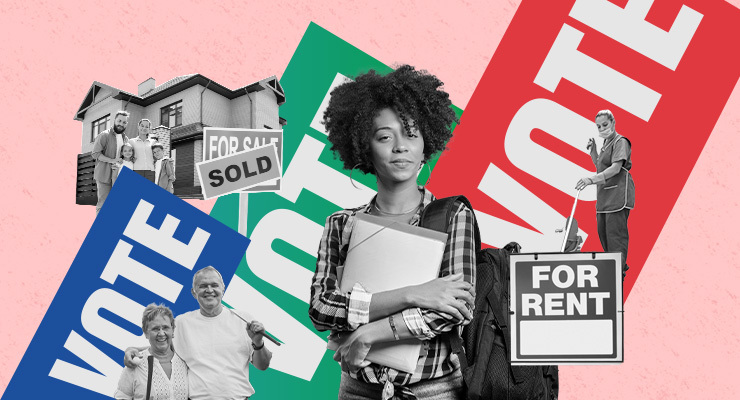
The 2019 federal election was meant to be a “youthquake”. On the back of all-time-high youth enrolments after the same-sex marriage survey, some pundits tipped a generational changing of the guard.
Needless to say it didn’t eventuate. As I wrote for Crikey at the time, “such predictions were blinded by hope, overlooking the inconvenient fact of our rapidly ageing population”. And all those boomers disproportionately backed Scott Morrison.
Fast-forward to the 2022 election. Youth enrolment was similarly high after a flurry of last-minute sign-ups, and Labor has declared victory amid a sea of independents and Greens. Are we witnessing a belated youthquake?
I wouldn’t call it such; the electoral map is still moving and its complex, contradictory shifts aren’t reducible to one variable. But early signs suggest young people made their presence felt in unprecedented ways.
Teals and Greens got a bump from young renters
Much has already been written about how women and the “moral middle class” have reasserted their political agency by flipping Liberal strongholds to independents. But it wasn’t simply that the affluent changed their minds — their electorates are also demographically changing.
The broader population might be getting older, but many inner-suburban seats, such as Victoria’s Kooyong and Higgins, have got younger as students and young renters have clustered in formerly old-money neighbourhoods that are now university and nightlife hubs. As Labor-aligned pollster Kos Samaras said in another Crikey article of mine: “Kooyong now boasts the highest number of voters aged under 24 in Victoria.” We saw this at the Victorian state election too.
The Queensland seats that delivered for the Greens are similarly young. In Griffith and Brisbane, 45% and 46% of Brisbane voters respectively are under 40, some of the highest proportions in the country (the average is low-mid 30s). Sure the Greens’ much-hyped “ground game” is commendable, but they’re playing on favourable turf.
After years of benefiting from Labor’s base fracturing, the Liberals are feeling the demographic squeeze too. They can no longer court the outer suburbs and mining regions while forsaking their trendifying metropolitan seats without consequence.
Homeowners still frustrated Labor
Another generational issue seems to have factored in: home ownership. The Coalition’s vote held up and Labor failed to make inroads in some suburban seats, such as Longman in Brisbane and Casey in Melbourne.
This is a similar dynamic to the 2019 election, in which Morrison effectively demonised Labor’s negative gearing and capital gains tax policies among suburban, homeowning families and retirees — albeit against a stronger anti-Coalition tide.
These outer suburbs are mostly home to middle-class, middle-aged families, including many migrants, who have purchased houses far from the CBD — the only place they can afford. Some vote Labor in line with their workplace and social interests, but many reflexively pull the property ladder up after themselves.
As University of Sydney Professor Anika Gauja recently said in The Conversation, there is a strong correlation between the average age of buying one’s first home (36) and the average age at which voters switch from being more likely to vote Labor or Greens to the Coalition (34 or 35).
Correlations do not necessarily equal causations, and people vote for myriad reasons. But it makes sense that homeownership can inculcate a degree of economic conservatism — your most valuable asset is now tethered to ratcheting wealth inequality. Labor’s abandonment of housing tax reform may have assuaged some of this cohort’s anxieties, but clearly not all.
A return to ‘big picture’ politics
Our major parties straddling demographic lines is preferable to America’s polarised system, with a widening gap between liberal, multicultural cities and reactionary, monocultural regions. Not only does that cause governmental dysfunction, but it also permits the right to plunge further into Fox News cuckoo land without answering to those outside its echo chamber.
For Labor, winning federal office is a rarity to be celebrated, but it too must contend with multidirectional headwinds, having underperformed in both the kitchen tables of exurban estates and in bohemian wine bars. Anthony Albanese can’t convincingly argue his moderation on climate and housing policies won him extra seats, and the former probably held the party back in some that were on offer.
Our major parties are unprecedently hamstrung, caught between young and old, renters and owners, aspirationals and battlers. The challenge for the Liberals is to heed the call of their haemorrhaging heartland amid the deranged calls to double down.
Meanwhile, Albanese must transcend Morrison’s cynical divisiveness, overcome his concerted timidity and return to common good universalism. There are simply too many cohorts in our complex electorate to cynically pander to one — for the others will soon take their revenge.








I hope that you’re correct, Clark. Neither party will look at housing as an issue until they’re absolutely forced to do so. Let us hope that these younger voters can maintain the pressure upon those they may have helped to elect.
Surely a policy whereby someone’s third and subsequent house cannot get tax relief would be a sensible middle way. Ensure that the family home plus one other house (beachside shack, city squat, kids house) are exempt and tax those with multiple houses.
Another option is to tax vacant houses. Those where there has been no one living there for, say, 6 months.
Grandfathering and graduated removal of the tax benefits can & should be adopted
Sorry. I own the house I live in, in a postcode many would consider undesirable. I do not regard it as a “valuable asset” but as a place to live, where I no longer have to pay either rent or mortgage repayment. I have not lost my ire at the injustice of our economic system. I am ropeable about the tax system that favours investors over people who just want somewhere to live. I also happen to think that, over time, we have had too great an immigration rate and that this is still playing out in current demand for housing.
DAMN STRAIGHT. There was nothing about immigration or lack thereof in the analysis here. No comprehensive economic analysis. More youthful, SA resentment at anyone that can add 2 and 2. I never have and could not afford to regard home ownership as a plaything or even as a proper investment. BTW that when you own more than 1 home, anything from the 2nd home after is considered an investment – notionally that is – even though one may not rent it out or use it for income producing purposes.
I am simply not that wealthy and at my age, lucky enough to have what I have. I am not like others, in business and politics, who own in excess of 5 homes. Doesn’t one own 19? A house for people like you and me is not a valuable asset except when we go for a bank loan to buy a car or another property. It is valuable only on paper and I also don’t live in a desirable postcode. I do love where I live and wouldn’t have a primary residence anywhere else. I’m not sure my wife would totally agree. In and of itself a house or a home, let’s be clear, is nothing but the provision of shelter.
Crikey! Sack this author.
Dawkin’s massification of higher education may have finally hit pay dirt for progressives.
Kooyong and Higgins have endured medium density housing developments. This has occurred in Wentworth as well. So less moneyed but better off trendy commercially oriented professionals and small business types have congregated into these areas. Close to work and can afford them and have nice restaurant and other professional business and government services that they want. Close to public transport. Medium to high density developments has changed the face and demography of these electorates. They used to be decent sized blocks of land on which homes were established. But many of the former inhabitants have sold off to developers and moved elsewhere. Perhaps to Bass or Lyons. To Flinders on the Mornington Peninsula. Or one of the 3 Gold Coast seats or to seats on the mid north coast. Students have taken up residence there as have young workers or not so young workers in one of the professional or knowledge or white-collar industries. Kooyong has gone “teal” and Higgins, the electorate of old Yellow, Peter Costello and his successor, KELLY O’Dwyer featuring the notoriously wealthy Toorak has gone Labor.
I get it. They certainly aren’t usual Labor or traditional Labor. They are not quite usual or traditional Liberal. The Greens are a bit off for most of them. Too far left. Leave that to Melbourne and the inner North of Northcote. They are the hme of professional Lefties and Greens while those residing however long in Higgins and Kooyong and even Goldstein, are aspirational, not abidingly Left, more enterprising, more economically focused, probably – no definitely- more ambitious. This is why they went “TEAL”. Didn’t appreciate Shorten’s tax proposals and policy suite in 2019, Albo scares them less in 2022. The same applies to those in Sydney. Labor not going to tax their investments and trusts. Will let them keep their extra $15,000/annum in tax cuts. Will tackle Climate change, courtesy of the taxpayer. Yep. No doubt about the Greens and “teals” and New Labor.